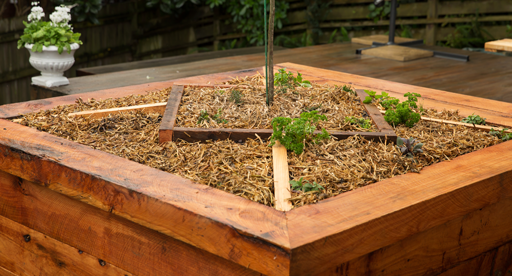
If you love to use homegrown veges and herbs in your cooking, create a garden that is easily accessible from your kitchen. Spring is the best time to plant your kitchen garden in time for summer entertaining.
Choose easy to grow veges and fragrant herbs to enjoy a variety of flavoursome ingredients in your culinary delights!
Prepare
Setting up your kitchen garden
Choose a spot for your garden that is close to your kitchen so you can easily go from garden to table, picking fresh herbs and veges and adding them straight into dishes the whole family can enjoy!
A raised garden bed is a great option to pack lots of different crops in. But even if you don't have a lot of space, you can create a kitchen garden in pots and containers.
If you are starting with a new garden bed, fill with Tui Vegetable Mix a high quality natural-based planting mix containing the right blend of nutrients to provide your veges with the best possible start and sustained growth throughout the season. Then mix in Tui Sheep Pellets.
Plant
The best times to plant are early in the morning or late in the day, so the plants aren’t exposed to the hot sun straight away.
Vegetable and herb options for your kitchen garden
It's a good idea to plant what you like to eat and enjoy cooking with.
- Potatoes for summer salads or served with lashings of mint and butter. Choose a potato variety from the Tui Certified Seed Potatoes range based on your taste and cooking preferences. Follow our guide to growing tasty spuds >
- Herbs for a fresh flavour punch to any meal: coriander, parsley, sage, mint (for the spuds!), basil, oregano, thyme, rosemary.
- Veges for a touch of green goodness: beetroot, bok choi, celery, lettuce, mesclun, spinach, spring onions, rocket. Once the weather warms, plant tomatoes for a summer harvest. Cherry and patio varieties are easy to grow in abundance and a tasty addition to salads.
Directions for planting veges and herbs:
- Soak seedlings in a bucket of Tui Organic Seaweed Plant Tonic and allow to drain. This will help prevent transplant shock.
- Dig a hole, approximately twice the depth and width of the root ball of your plant.
- Gently loosen the root ball of your plant and position the plant in the centre of the hole.
- Press soil gently around the base of the plant.
- Water your plants well.
- Add layers of Tui Pea Straw Mulch to help keep their roots moist and to keep your garden weed free.
- To prevent slugs and snails eating your plants before you have the chance to enjoy them lay Tui Quash slug & snail control.
For more delicious options to plant in your kitchen garden our planting calendar has a handy list detailing what to plant each month, based on your region.
Nourish
Plants also get hungry! Feeding them will replenish nutrients used as they grow and will mean more food to use in the kitchen to create tasty meals.
Use a fertiliser specially blended for what you are planting such as Tui Potato Food for potatoes, or use an all purpose variety such as Tui Enrich Vege, Tomato & Herb fertiliser which is also suitable for pots and containers.
Tui Tips:
- If you are creating your kitchen garden in an existing garden bed top up with organic matter like Tui Sheep Pellets and compost to your soil.
- If planting your kitchen garden in pots and containers fill them with Tui Vegetable Mix before planting.
Shopping list:
- Tui Sheep Pellets
- Tui Vegetable Mix
- Tui Certified Seed Potatoes
- Salad seedlings
- Herb seedlings
- Tui Organic Seaweed Plant Tonic
- Tui Pea Straw Mulch
- Tui Quash slug & snail control
- Jan
- Feb
- Mar
- Apr
- May
- Jun
- Jul
- Aug
- Sep
- Oct
- Nov
- Dec
- Harvest in 60-85 days
Post a comment
Kitchen Garden Guide Comments
Be the first to write a comment